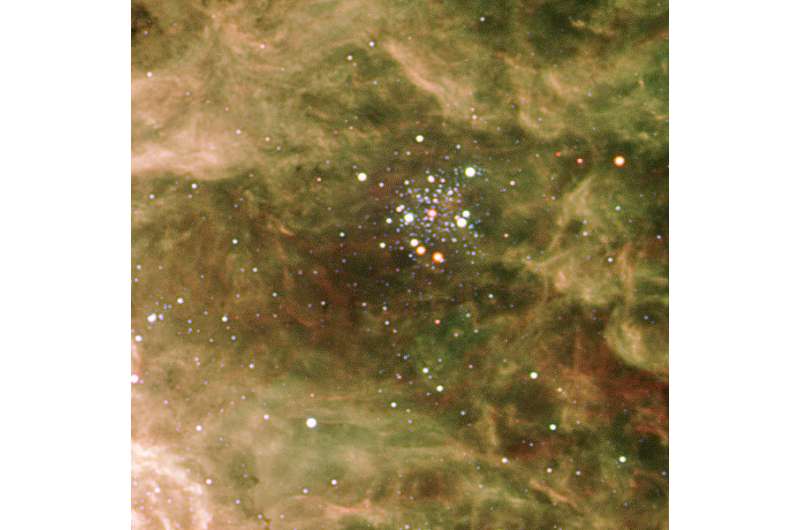October 27, 2016 report
The oldest star cluster in Tarantula Nebula even older than previously thought, study finds

(Phys.org)—The Hubble Space Telescope Hubble Tarantula Treasury Project (HTTP) survey has revealed new insights on the star formation history of the oldest star cluster in the Tarantula Nebula (also known as 30 Doradus), designated Hodge 301. According to a study published Oct. 19 on arXiv.org, this star cluster could be even several million years older than previously estimated.
Located some 168,000 light years away, Hodge 301 is one of two major star clusters in the Tarantula Nebula. The cluster is known for its high supernovae activity as scientists calculate that at least 38 stars within it have already exploded as supernovae. Previous studies have estimated that the cluster's age ranges from 20 to 25 million years.
Now, an international team of astronomers, led by Michele Cignoni of the University of Pisa in Italy, has used the photometric capabilities of the HTTP survey to better understand Hodge 301's formation history and measure its age more accurately. For their study, they focused on the optical color-magnitude diagram of H301, the only one deep enough to reach 30-million-year-old pre-main sequence stars.
In effect, they found that this cluster could be several million years older than previously assumed.
"Thanks to the photometric capabilities of the HTTP dataset, we have detected the pre-main sequence turn-on for the first time. The peak age we derive from fitting this feature and the main-sequence turn-off [is] between 26.5 and 31.5 Myr," the researchers wrote in the paper.
Taking the new calculations into account, they added that Hodge 301 is much older than the bulk of the stars in NGC 2070—the most active region of the Tarantula Nebula. However, it is only slightly older than its oldest stars, which are approximately 20 million years old.
Besides estimating the cluster's age more accurately, the team managed to calculate Hodge 301's total stellar mass and its total reddening. According to the paper, the cluster has a mass of about 8,800 solar masses and a reddening of approximately 0.23 mag, with a dispersion of 0.04 mag.
"From comparison of the observed color-magnitude diagram with simulations based on stellar evolutionary models, we derive in a self-consistent way the age distribution and reddening of Hodge 301," the team wrote.
Moreover, the scientists estimated the number of supernovae that exploded in Hodge 301. They revealed that the total amount ranges from 38 to 61 supernovae Type-II, what was derived from the cluster's age.
All those results allowed the team to conclude that the Hodge 301 cluster in its early stages of creation could gave birth to NGC 2070.
"From the point of view of the Tarantula Nebula, the old age of H301—several Myr older than the nearby and massive NGC 2070—and its high supernovae activity, along with the fact that no older clusters are visible in the region, could suggest that the onset of H301 sparked the formation of NGC 2070," the paper reads.
More information: Hubble Tarantula Treasury Project V. The star cluster Hodge 301: the old face of 30 Doradus, arXiv:1610.06180 [astro-ph.SR] arxiv.org/abs/1610.06180
Abstract
Based on color-magnitude diagrams (CMDs) from the Hubble Space Telescope Hubble Tarantula Treasury Project (HTTP) survey, we present the star formation history (SFH) of Hodge~301, the oldest star cluster in the Tarantula Nebula. The HTTP photometry extends faint enough to reach, for the first time, the cluster pre-main sequence (PMS) turn-on, where the PMS joins the main sequence. Using the location of this feature, along with synthetic CMDs generated with the latest PARSEC models, we find that Hodge~301 is older than previously thought, with an age between 26.5 and 31.5 Myr. From this age, we also estimate that between 38 and 61 supernovae Type-II exploded in the region. The same age is derived from the main sequence turn-off, whereas the age derived from the post-main sequence stars is younger and between 20 and 25 Myr. Other relevant parameters are a total stellar mass of ≈8800±800M⊙ and average reddening E(B−V) ≈0.22−0.24 mag, with a differential reddening δE(B−V)≈0.04 mag.
© 2016 Phys.org





















